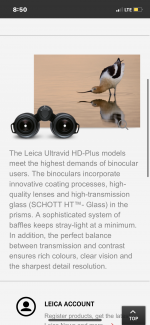According to Leica they use the exact same quality glass in both the UV and the noctovid so it would have to be the design that makes some perfer it, not the glass quality.
The same applies for the SLC hd when compared to the EL’s or NL’s, they have different designs sure, but the same glass quality and coatings are used through out according to Swarovski. And in the SLC 56’s, without peer imo optically, they have the ak prisms.
Yea the larger glasses may lose out for weight, size, and everyday handling, but in my experience most 42’s deliver a better more enjoyable image that 32’sand most 50’s deliver a better more natural image than 42’s, again all of the same make, not an alpha 42mm vs a 2nd rate 50mm.
At least that’s been my experience with Swaro and Leica, the Swaro 10x50 el/56 slc delivers a better view than the 10x42 el/slc imo, same for the Leica 50’s vs their smaller counterparts.
Is the above logic is true then why bother with a 42 when a 32 should deliver the same or better image, or even a 20mm mini, again assuming we’re all using the same quality.
1. Out of curiosity, where have you come across this confirmation that Leica uses the exact same glass in the UV & NV? And Swarovski with the EL & NL?
2. Glass asside, optical design does make a huge difference with many binoculars in the same series but different sizes having significantly more or less elements.
3. Precisely what do you classify as a "better and more enjoyable image"? Because my experience contradicts yours here - a larger bin is not always superior to me! For example, I recently tested the Victory SF 8x32 vs the 8x42 - both equally bright and sharp, with the smaller bin being pretty substantially smaller and lighter and having an even wider FOV! And not a huge difference around sunset either - with the 42 maybe gaining the slight edge in the last 10-15 minutes of the day. Likewise, I own a Victory 8x25 as well as a Conquest HD 8x32 and I find the little Victory Pocket to be the superior of the two! While it has slightly less FOV, it has less CA and is brighter for the vast majority of the day (which is 95% of my use), and absolutely tiny to the point where it literally fits in my pocket (perfect for hikes and even trips to the park). To a certain extent each of our preferences depends on our personal use cases - for someone like me, who mostly only uses binoculars before dark, even the small 3.1mm exit pupil that the VP 8x25 provides truly does the job. And I live in England - where it is cloudy very often and gets dark around 4pm in winter!
4. Comparing a 42 and a 20 is really not a fair comparison - a quality 8x32 can easily substitute for a 8x42, but there is a huge difference in the size of the exit pupil of a 20 and a 42. Another example: I bought an Ultravid 8x20 for my wife, and while it is certainly capable of providing pleasing views in brightly lit conditions, it is bested in
all conditions by every one of the binoculars I have previously mentioned (including by the only slightly larger VP 8x25).
I think you misunderstood the point I was trying to make here. The main benefit of a larger sized binocular is its
better low light performance vs ones with smaller objectives. You effectively trade size, weight, and cost for a few extra minutes of use / slightly better performance in dim conditions. That is the whole reason why binoculars are offered in so many different sizes - because many people (myself included) would much rather have the option of something small, light and easy to carry than a larger, heavier binocular that provided a marginally brighter views in dim conditions. You originally asked about how the 10x50 UVHD+ would compare against the smaller 10x42 SF. The point I was trying to make was that the SF 10x42's -
being pretty much at very top of their class - could easily substitute for the bigger (and slightly optically inferior) 10x50 UVHD+. As both an UVHD+ and SF owner, I'd be willing to bet that the views for the vast majority of the day (up until perhaps the last 15 minutes before sunset) would probably be
better with the SF's (greater FOV, brighter glass, less CA and sharp pretty much right to the edge).








